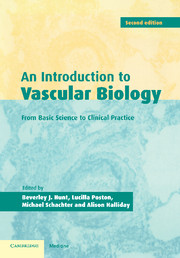10 - Nitric oxide
Published online by Cambridge University Press: 07 September 2009
Summary
Introduction
Since the discovery of endothelial-derived nitric oxide (NO) as a potent vasodilator, NO has been implicated in a variety of biological roles. This chapter aims to provide a general overview of the role of NO in normal physiology of the vasculature as well as pathophysiology in disease states.
From EDRF to nitric oxide
In 1980, Furchgott and Zawadzki demonstrated that the presence of vascular endothelial cells is essential for acetylcholine (ACh) to induce relaxation of isolated rabbit aorta. If the vascular endothelium is injured or mechanically removed, the blood vessel fails to relax to ACh but still responds to glyceryl trinitrate (GTN). This endothelial-dependent relaxation of vascular smooth muscle to ACh is mediated by a humoral factor, initially named endothelium-derived relaxing factor (EDRF; Furchgott and Zawadzki, 1980). The exact bio-chemical identity of EDRF was the focus of intense research and in 1986 Furchgott and Ignarro independently suggested that NO might account for the biological properties of EDRF (Furchgott, 1988; Ignarro et al., 1988). This was confirmed a year later (Ignarro et al., 1987; Palmer et al., 1987).
The L-arginine–nitric oxide pathway
Endothelium-derived NO is synthesized from one of the guanidine-nitrogen atoms of the amino acid l-arginine by the endothelial isoform of NO synthase, yielding l-citrulline as a byproduct (Palmer et al., 1988; Schmidt et al., 1988). NO is labile and has a short half–life (10–60 s; Knowles and Moncada, 1992).
- Type
- Chapter
- Information
- An Introduction to Vascular BiologyFrom Basic Science to Clinical Practice, pp. 216 - 258Publisher: Cambridge University PressPrint publication year: 2002
- 1
- Cited by



